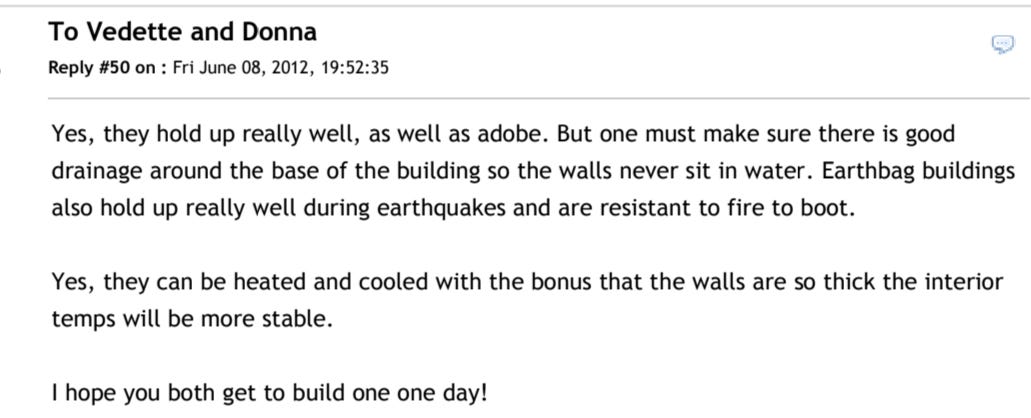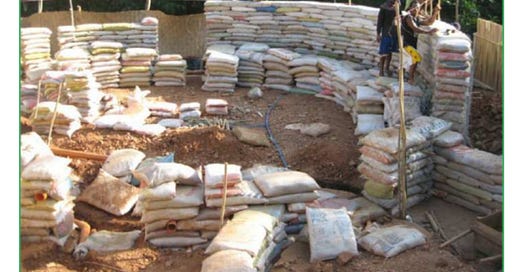Earth bag homes - adobe style dome homes are earthquake and fire resistant -but need good drainage.
Also, bioactive phosphorus supply and agricultural chemical run-off causing ocean dead zones. We are part of natural cycles which we are disrupting.
Climate change as talked about by the media and politicians might be fictional, however ecosystem destruction due to agricultural chemicals and plastic waste is a real concern harming marine life and us too. Microplastics are being found in our food and water supply and in tissue samples. Shifting the discussion from Carbon Tax Credits to strategies that would really help reduce harm is needed.
Team Earth needs everyone to start thinking how their efforts small, medium, or Grande' sized, can help us now and also help the future. How we build our homes can help protect us better and have a lower impact on Earth’s resources.
Extreme weather housing
Sustainable housing that is resistant to the extreme weather typical of the local region is also a need. Dome style earth homes have been found effective in mountainous regions of Tibet.

Sandbags are stacked with Barb wire between the layers to help hold them in place. The thick sandbag walls are finished with a layer of concrete smoothed into an adobe style finish.

Severe wind or avalanching rubble can rush over the top of the thick dome walls without causing the damage seen with wooden structure homes. Some earth Bag Homes are made with a more typical roof though, on top of sandbag walls.

Plans and images can be seen here:
18 Beautiful Earthbag House Plans for a Budget-Friendly Alternative Housing, by Jennifer Poindexter, morningchores.
Earth bag building courses: (calearth.org).
Earth Bag Homes, pdf (dropbox.com), *The images in this post are from this document.
Nepal Engineer's Association Technical Journal, Earthbag Technology - Simple, Safe, & Sustainable. (detailed plans including lists of materials that might be required), (sherpaguan.free.fr/pdf)
More resources regarding construction of dome homes for reducing risk in wildfire or use in other disaster-prone areas:
Earth Bag Domes for High Fire Risk Areas, (naturalbuildingblog.com) .
Disaster Resistant Earthbag Housing, (motherearthnews.com) .
How to Build an Earthquake-Resistant Home: An Earthbag Construction Manual (Nepal, straight wall construction rather than dome shaped plans fora areas with earthquake risk more than wildfire), (engineeringforchange.org) .
Sandbag Construction (for flood zone area barriers), (cityofconcord.org/pdf)
FEMA Home Builder's Guide to Construction in Wildfire Zones, (fema.gov/pdf).
Preassembled Dome Homes - buy a kit - not good for locations with wildfire risk.
Japan Dome Home, i-domehouse.com. Prefabricated dome pieces make quick assembly possible.
The Japanese Dome Home is a prototype design for easy to assemble, weather and natural disaster resistant, dome homes. The homes can be put together in a few different shapes from preformed pieces and the dome roof effect retains heat more easily requiring lower heating costs. These rapid installation prefab Japanese may be good in hurricane/wind conditions but not be good for wildfire risk zones as they are made from polystyrene.

Having a place to call your own for sleep and privacy can help reduce stress and protect health. Whether too hot, too cold, too windy, rainy or humid, or too dry, weather conditions can affect health and may make it more difficult to get a good night's sleep. Having a place to store your personal things and get cleaned up and dressed each day can help with a sense of self and ability to make it to a job each day in a condition that is ready for work.
The price of housing is more expensive than many minimum wages could afford with no other purchases. Zoning regulations in many urban areas limit apartment buildings and prioritize homes with yards. Mini houses in the backyard are being built in some areas for extra privacy for the home-owner's family but sometimes they are being built for a homeless person. An interesting construction style that is low cost and durable for withstanding extreme weather and insulating during heat or cold involves the use of sandbags filled with sand or dirt. The sandbags are used like large bricks and stabilized with wire fencing and concrete. The completed homes look like adobe style buildings.

We need more housing in general but also housing that is designed with the environmental conditions that are on the way. "Climate change" is a cover story for larger changes in our planet's magnetosphere. As it weakens, extreme weather and geological events are more likely. Extreme shifts in temperature out of season are occurring as the planet's wobble gets larger - we feel the temperature change rapidly as the planet swings closer to or farther away from the sun and then again a few days later as the planet wobbles back. Picture a spinning children's top wobbling as it slows down.
Areas with very high temperatures now might want to start making underground cooling areas. The temperature after a certain depth is always cool - jacket weather and a campfire.
Sanitation systems may need significant changes for areas with less water and also to work better with the natural reuse cycle of phosphorus in traditional agriculture. Compost is part of the cycle of life, along with spring growth and winter rest.
Disclaimer: This information is being provided for educational purposes within the guidelines of Fair Use and is not intended to provide individual health guidance.





